All-Purpose Creams
Over the years, cosmetic companies have produced a wide range of specialist skin-care cosmetics each developed for a specific purpose or problem. All-purpose creams used a different approach. As their name suggests, they were formulated to cater for a wide range of purposes, to replace a number of speciality creams with a single product, an idea that was generally condemned by salon-based companies like Elizabeth Arden.
Elizabeth Arden was probably the first authority to condemn the use of an all-purpose cream and to develop her complete group of specialized preparations to fulfill every need and to correct every fault of the skin. …
Elizabeth Arden considers it of the greatest importance that her Preparations [sic.] be correctly chosen and her method correctly applied.(Elizabeth Arden, 1928, p. 9)
Cold Cream
The all-purpose cream Arden was condemning was probably cold cream, a venerable skin-care cosmetic that could function as a cleanser, skin beautifier, night cream and, for some, a base for powder. Cosmetic companies that sold all-purpose creams sometimes denigrated ’ordinary’ cold creams as well. However, it was more usual for them to promote their all-purpose creams as a replacement for three or four specialist preparations, one of which was cold cream.
The Lady Esther company took this idea to heart, naming its all-purpose cream as a Four-Purpose Cream that could replace a cold cream, skin food, astringent and powder base.
Each application has four distinct actions on the skin.
Cleansing action that cleanses the pores and thus ends the use of an ordinary cleansing cream.
Tissue stimulating action that invigorates the deep tissues of the skin. And thus ends that use of a special “skin food.”
Astringent action that eradicates worry strain and premature age lines, refines pores. And thus makes the use of youth creams and astringents a folly.
Softening action that forms a perfect base for powder. And thus banishes the need of a powder base.(Lady Esther advertisement, 1930)
Other companies followed a similar line. Jergen’s Face Cream was also said to act in four ways.
This one new cream—(1) cleanses expertly; (2) helps soften your skin, because of its light rich oils; (3) gives a lovely smooth finish for powder and make-up; (4) acts as a fragrant Smooth Skin night cream that helps wonderfully against sensitive dry skin. And, girls, very dry skin tends to winkle early!
(Jergens advertisement, 1940)
Sports creams
In Europe, all-purpose creams were often referred to as ‘sports creams’, a reflection of the widespread adoption of Nivea Creme, a popular German all-purpose cream made by Beiersdorf that could be used to protect the skin during outdoor activities and sports.
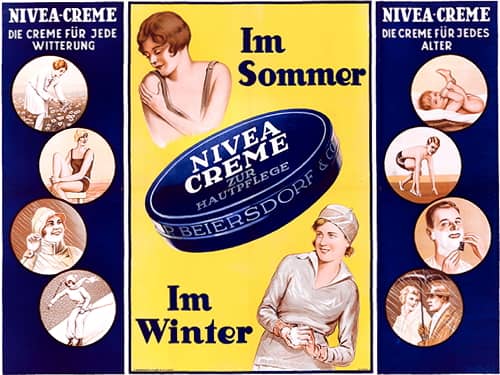
Above: 1933 Beiersdorf Nivea Creme.
In the 1950s, Nivea would up the ante on three or four functions and claim to be a 9-purpose cream.
Nivea is all these things . .
Hand Cream keeps hand as smooth as silk.
Cleansing Cream removes pore-deep grime.
Night Cream nourishes underlying tissues.
Powder Base especially for dry skin.
Baby Cream for napkin rash amd baby skin-care.
Sun Cream for all outdoor enthusiasts.
Soothing Cream for winter chapping, minor burns add abrasions.
Sports Cream for massage and rough skin.
A Man’s Cream particularly for sore chins.(Nivea advertisement, 1952)
Antoine’s Crème pour le Ski, known as Ski Cream in America, was another example of a European sports cream. It started out as a cream for winter sports but became an all-purpose skin protector that could even be used as a make-up base.
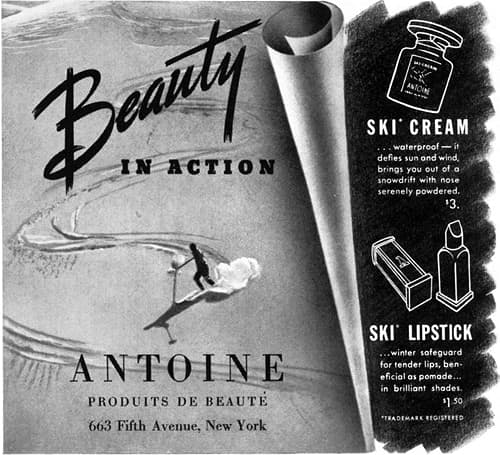
Above: 1939 Antoine Ski Cream and Ski Lipstick.
See also: Antoine
Market
All-purpose creams have always been popular, but were particularly so during the Great Depression of the 1930s when most household budgets were tight.
There are all-purpose creams that can be used for cleansing, lubricating, and make-up foundation. In fact, these are gala days for the “one-cream” woman who doesn’t want to be bothered with a raft of preparations. Some of the best-known manufacturers put out all-purpose creams that are ideal for the busy woman who has an average skin without serious faults to correct.
(Neil, 1937)
A number of new all-purpose creams came on the market during the 1930s, priced and positioned at the lower end of the cosmetic market. Most tried to avoid drawing attention to the bad economic situation by stressing their skin-care benefits and/or their ability to save time rather than suggest that using them would save money.
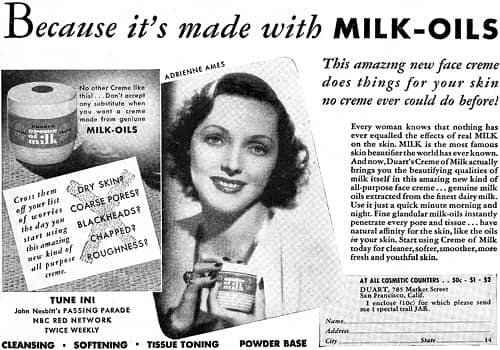
Above: 1937 Duart Cream of Milk all-purpose face cream with advertising focused on its unique formulation and on its ability to solve a number of skin-care problems rather than price.
Some of these new creams tried to elevate their status with endorsements from eminent personalities, a strategy also tried by Pond’s. For example, Theron Laboratories, a British firm, named their all-purpose cream Princess Marguerite after getting an endorsement from Princess René of Bourbon-Parma [1895-1992], a relative of the Danish royal family who was living very modestly in France and could do with the cash.
See also: Pond’s Extract Company
Not every all-purpose cream was marketed as a cheap alternative. Estée Lauder – now associated with a wide range of specialist skin-care cosmetics – had an all-purpose cream in her original range. This sold for decades before it was discontinued. As Leonard Lauder [b.1933] noted in 1984 “We’re in the era of technology and specific products. In 1946, we introduced our super rich, all-purpose cream. Today there is no longer all-purpose anything.” (“Beauty review: Computing skin care,” 1984).
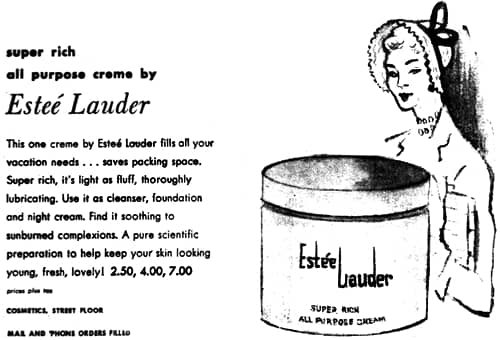
Above: 1949 Estée Lauder Super Rich All Purpose Cream – a cleanser, lubricant, night cream and skin conditioner.
All-purpose creams are still popular today for a variety of reasons including suitability, price, simplicity of use and general convenience. Wilkinson & Moore put some of these ideas into a list of marketing suggestions, some of which show an obvious negative bias:
There appears to be a market for an all-purpose cream and some of the possible sales outlets for such a product are:
(a) the unsophisticated user who lacks space and/or money and who therefore buys one cream to do as much as possible;
(b) the slightly more sophisticated user who buys a speciality cream for one particular function and relies on an all-purpose cream for all other functions;
(c) the user who finds the all-purpose cream ideally suited for her particular skin for a particular function and uses it as a speciality cream;
(d) the user who normally fragments her skin creams but resorts to an all-purpose cream when travelling or on holiday;
(e) for general family use and protection against the elements.(Wilkinson & Moore, 1982, p. 71)
Formulation
At first, cosmetic chemists simply modified cold creams by adding lanolin, or one of its derivatives, producing what some have referred to as an ‘all-purpose type’ of cold cream. Nivea Creme can perhaps be considered a cream of this type. It was made with Eucerit, a trademarked lanolin alcohol.
Some example recipes for all-purpose type cold creams:
No. 10—All purpose type Per cent Sesame oil 42.5 Lanolin 14.5 White beeswax 5.5 Spermaceti 6.0 Borax 0.5 Water 30.5 Perfume 0.5 (Chilson, 1934, p. 100)
No. 11—All purpose type Per cent Lanolin absorption base 20.0 White mineral oil (65-75) 50.0 Water 14.5 White beeswax 15.0 Perfume 0.5 (Chilson, 1934, p. 100)
See also: Cold Creams
Other versions combined some of the properties of cold creams with those of vanishing creams. This allowed the all-purpose cream to be used for cleansing, softening and protecting the skin as well as a base for face powder.
Lanolin or lanolin derivatives were still added as emollients but the greasiness of the cold cream was reduced by replacing part of the oil phase with stearic acid or something similar to give the cream some of the characteristics of a vanishing cream. Some formulations also included glycerin or another polypol as a humectant. The resulting water-in oil (W/O) or oil-in water (O/W) creams retained most of the properties of a cold cream, which meant they could act as a cleanser and emollient. The presence of lanolin also allowed them to claim to be a skin food, while the thin film they left on the skin after the cream was removed worked as a base for face powder.
Some example recipes:
Four Purpose Cream Lanolin 12.0% Mineral Oil 65/75 24.0% Stearic Acid 4.0% Stearyl Alcohol 4.0% Spermaceti 6.0% Cetyl Alcohol 8.0% Olive Oil 4.0% Triethanolamine 1.0% Water 37.0% (Keithler, 1956, p. 55)
Sports Cream parts by wt. Lanolin, cosmetic grade 18.0 Mineral Oil (65/75° Saybolt) 8.0 Paraffin wax (m.p. 52°C) 2.0 Petrolatum, short fiber 10.0 Magnesium sulphate 0.2 Magnesium stearate 0.5 Wool wax alcohols 1.0 Cetyl Alcohol 0.5 Preservatives and perfume 0.5 Distilled water 59.3 (Wells & Lubowe, 1964, p. 107)
All-purpose Cream per cent Stearic acid 15.0 Lanolin 2.0 Beeswax 2.0 Mineral oil 24.0 PEG-40 stearate 5.0 Sorbitol 10.0 Water, perfume, preservative q.s. (Wilkinson & Moore, 1982, p. 71)
See also: Skin Foods and Vanishing Creams
When heavier creams fell out of favour, many companies making all-purpose creams introduced an all-purpose lotion or milk to their range. Beiersdorf, for example, added Nivea Milk to Nivea Creme in 1963.
Either cream or lotion, these skin-care cosmetics are still popular today. Most are no longer specifically branded as all-purpose. Nivea, for example, with a long history as an all-purpose cream, simply states that it is “ideal for daily use wherever skin needs care”.
First Posted: 23rd September 2019
Last Update: 8th March 2022
Sources
Beauty review: Computing skin care. (1984, December 9). The New York Times, p. 139.
Elizabeth Arden. (1928). The quest of the beautiful [Booklet]. USA: Author.
Barnett, G. (1972). Emollient creams and lotions. In M. S. Balsam, & E. Sagarin (Eds.). Cosmetics: Science and technology (pp. 1-104). New York: Wiley-Interscience.
Clark, R. (1963). Cosmetic creams and lotions. In H. W. Hibbott (Ed.) Handbook of cosmetic science: An introduction to principles and practice (pp.257-294). New York: The Macmillan Company.
Keithler, W. M. R. (1956). The formulation of cosmetics and cosmetic specialties. New York: Drug and Cosmetic Industry.
Neil, E. (1937, September). Fall Faces. Screenland. XXXV(5), pp. 63, 70.
Wells, F. V., & Lubowe, I. I. (1964). Cosmetics and the skin. New York: Reinhold Publishing Corporation.
Wilkinson J. B., & Moore, R. J. (Eds.). (1982). Harry’s cosmeticology (7th ed.). New York: Chemical Publishing.
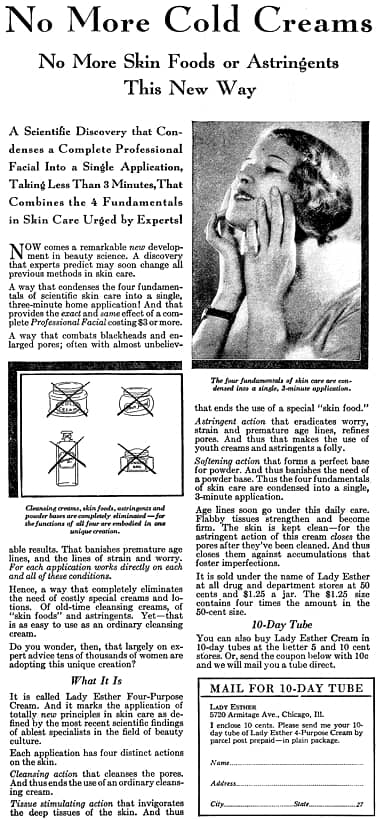
1930 Lady Esther Four-Purpose Cream.
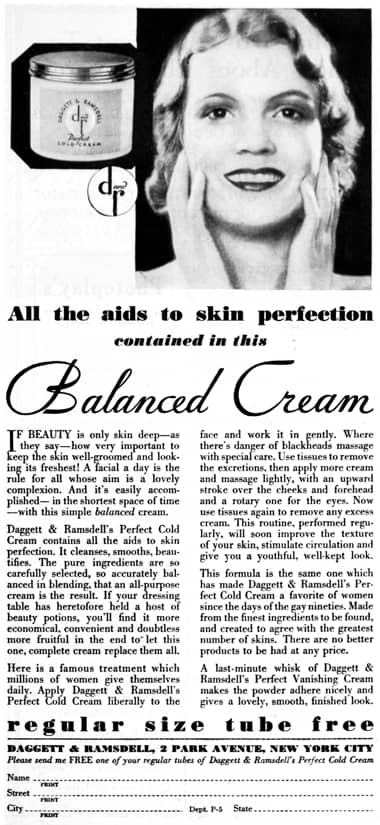
1931 Daggett & Ramsdell Perfect Cold Cream.
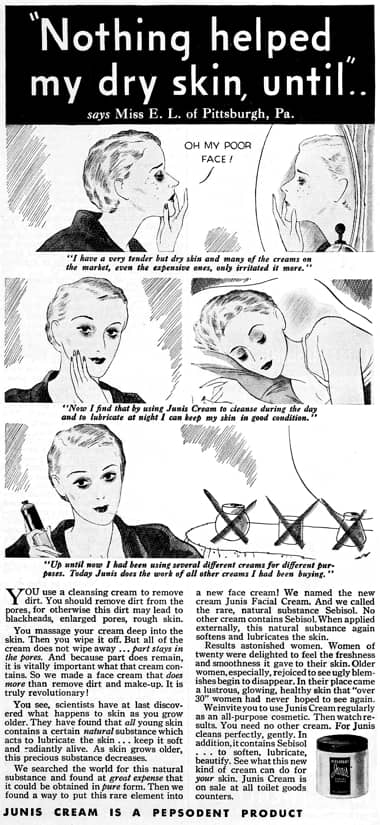
1935 Pepsodent Junis.
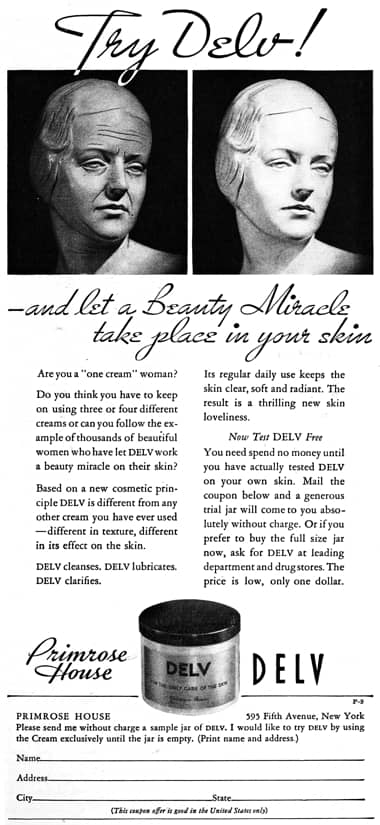
1935 Primrose House Delv.
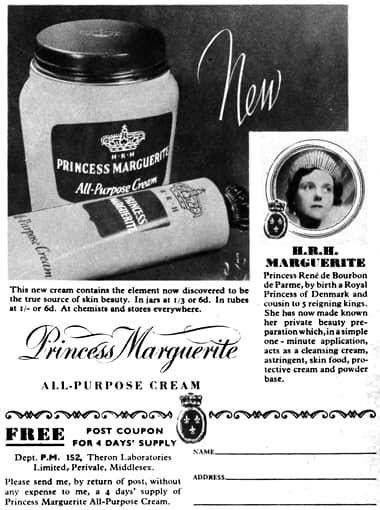
1937 Princess Marguerite All-Purpose Cream.

1937 Diadermine, a French all-purpose cream.
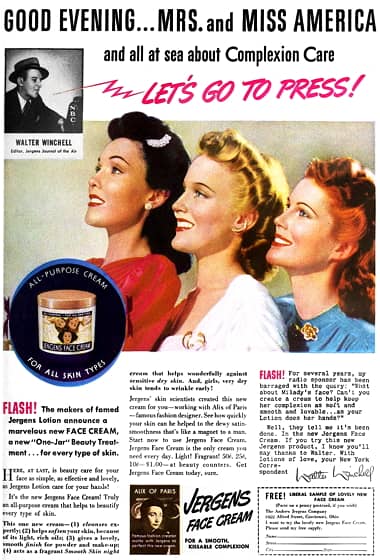
1940 Jergens Face Cream.

1947 Nivea Cream.
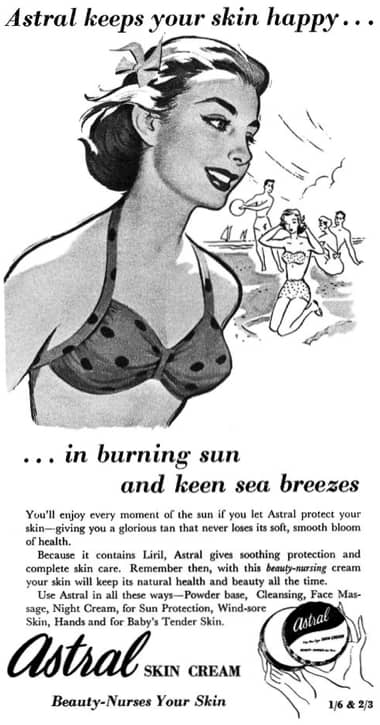
1951 Astral Cream, also with 9 purposes.
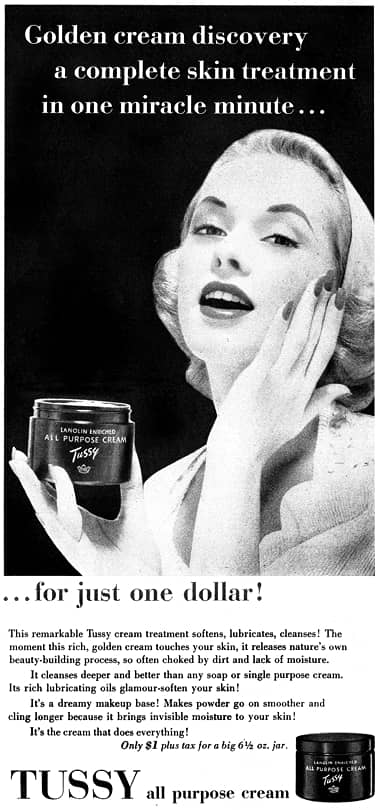
1955 Tussy all purpose cream.
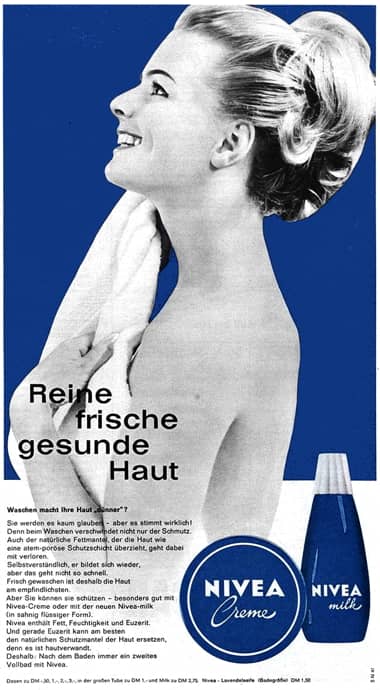
1964 Nivea Creme and Milk.
